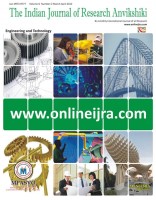Research Paper

An effect of Plasma physics in High Power Microwave Modules and Terahertz Devices
Author: *Ram Gopal Sonker, *Anand Gandhi Patel, *Vikas Mishra
*Ram Gopal Sonker
*Head, Department of Electronics & Communication Engineering, SHEAT College of Engineering, Varanasi
and Assistant Center Controller (ACS) through GBTU Lucknow ( mail- id rgsindiaglobal.zone@gmail.com)
*Anand Gandhi Patel
*Assistant Professor, Department Electronics & Communication Engineering, SHEAT College of Engineering,
Varanasi (mail- id engganand.gandhi@gmail.com )
*Vikas Mishra
* Assistant Professor, Department Electronics & Communication Engineering, SHEAT Col
Download PDF
Abstract
The authors have proposed introducing a micro pulse power technology in high power plasma experiments to boost up the return current, resulting in efficiently guiding of energetic electrons. The high current pulse power generators with a pulse trigger system generate high-density plasma that is well conductor.
The plasma filling has been credited with increasing the electron beam current, bandwidth, efficiency and reducing or eliminating the need for guiding magnetic fields in microwave sources. The Neutralization of the e-beam space charge by plasma enhances the current capability and beam propagation, and the generation of hybrid waves in plasma-filled sources increases the electric field on axis and improves the coupling and efficiency. Control of the plasma density in these microwave sources is often required to avoid instabilities and variations in the output power level and pulse length. Nonlinear properties of the electron plasma in the transistor channel can be used for the detection and mixing of THz frequencies. At cryogenic temperatures resonant and gate voltage tunable detection related to plasma wave resonance is observed. At room temperature, when plasma oscillations are over damped, the FET can operate as an efficient broadband THz detector. We present the main theoretical
and experimental results on THz detection by FETs in the context of their possible application for THz imaging.